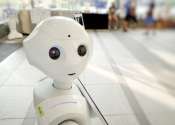Robotic moving 'crew' preps for work on moon
As NASA moves forward with efforts to establish a long-term presence on the moon as part of the Artemis campaign, safely moving cargo from landers to the lunar surface is a crucial capability.

As NASA moves forward with efforts to establish a long-term presence on the moon as part of the Artemis campaign, safely moving cargo from landers to the lunar surface is a crucial capability.
Space Exploration
Sep 25, 2024
0
1

A research team has unveiled an innovative technology for ultraprecision surface polishing and cleaning using simultaneously operating magnetic micro spinbots. These tiny robots, capable of nanometer-scale contaminant removal ...
Nanomaterials
Sep 20, 2024
0
12

Researchers said on Monday they had designed the first robotic leg with "artificial muscles"—oil-filled bags allowing machines to move more like humans—that can jump nimbly across a range of surfaces.
General Physics
Sep 9, 2024
4
10

Rover trials in a quarry in the U.K. showing a four-wheeled rover, known as Codi, using its robotic arm and a powerful computer vision system to pick up sample tubes.
Space Exploration
Sep 6, 2024
0
23

Researchers have created nanoscale robots which could be used to manage bleeds in the brain caused by aneurysms. The development could enable precise, relatively low-risk treatment of brain aneurysms, which cause around ...
Bio & Medicine
Sep 6, 2024
0
27

Do you think a robot should be allowed to lie? A new study published in Frontiers in Robotics and AI investigates what people think of robots that deceive their users.
Social Sciences
Sep 5, 2024
0
11

In today's digital reality, where virtual classrooms are increasingly commonplace, it's essential to know how to make online education as impactful as traditional face-to-face learning. A recent study conducted at Cluster ...
Social Sciences
Sep 4, 2024
0
5

The GEOEO North of Greenland 2024 Expedition, organized by the Swedish Polar Research Secretariat aboard the icebreaker Oden, has made history as the first vessel to reach the remote Victoria Fjord in North Greenland.
Earth Sciences
Aug 26, 2024
0
2

Scientists on a return journey to Beagle Marine Park in central Bass Strait have spotted thousands of sleepy Port Jackson sharks blanketing the seafloor.
Plants & Animals
Aug 14, 2024
0
27

Bumblebees have a great capacity to navigate despite their small brain size. This is borne out of new research conducted at Lund University in Sweden. The research results can potentially benefit the development of navigation ...
Plants & Animals
Aug 14, 2024
0
25
Robot is a virtual or mechanical artificial agent. In practice, it is usually an electro-mechanical system which, by its appearance or movements, conveys a sense that it has intent or agency of its own. The word robot can refer to both physical robots and virtual software agents, but the latter are usually referred to as bots. There is no consensus on which machines qualify as robots, but there is general agreement among experts and the public that robots tend to do some or all of the following: move around, operate a mechanical limb, sense and manipulate their environment, and exhibit intelligent behavior, especially behavior which mimics humans or other animals. In South Africa, robot is an informal and commonly used term for a set of traffic lights.
Stories of artificial helpers and companions and attempts to create them have a long history but fully autonomous machines only appeared in the 20th century. The first digitally operated and programmable robot, the Unimate, was installed in 1961 to lift hot pieces of metal from a die casting machine and stack them. Today, commercial and industrial robots are in widespread use performing jobs more cheaply or with greater accuracy and reliability than humans. They are also employed for jobs which are too dirty, dangerous or dull to be suitable for humans. Robots are widely used in manufacturing, assembly and packing, transport, earth and space exploration, surgery, weaponry, laboratory research, and mass production of consumer and industrial goods.
Modern robots are usually used in tightly controlled environments such as on assembly lines because they have difficulty responding to unexpected interference. Because of this, most humans rarely encounter robots. However, domestic robots for cleaning and maintenance are increasingly common in and around homes in developed countries, particularly in Japan. Robots can also be found in the military.
This text uses material from Wikipedia, licensed under CC BY-SA